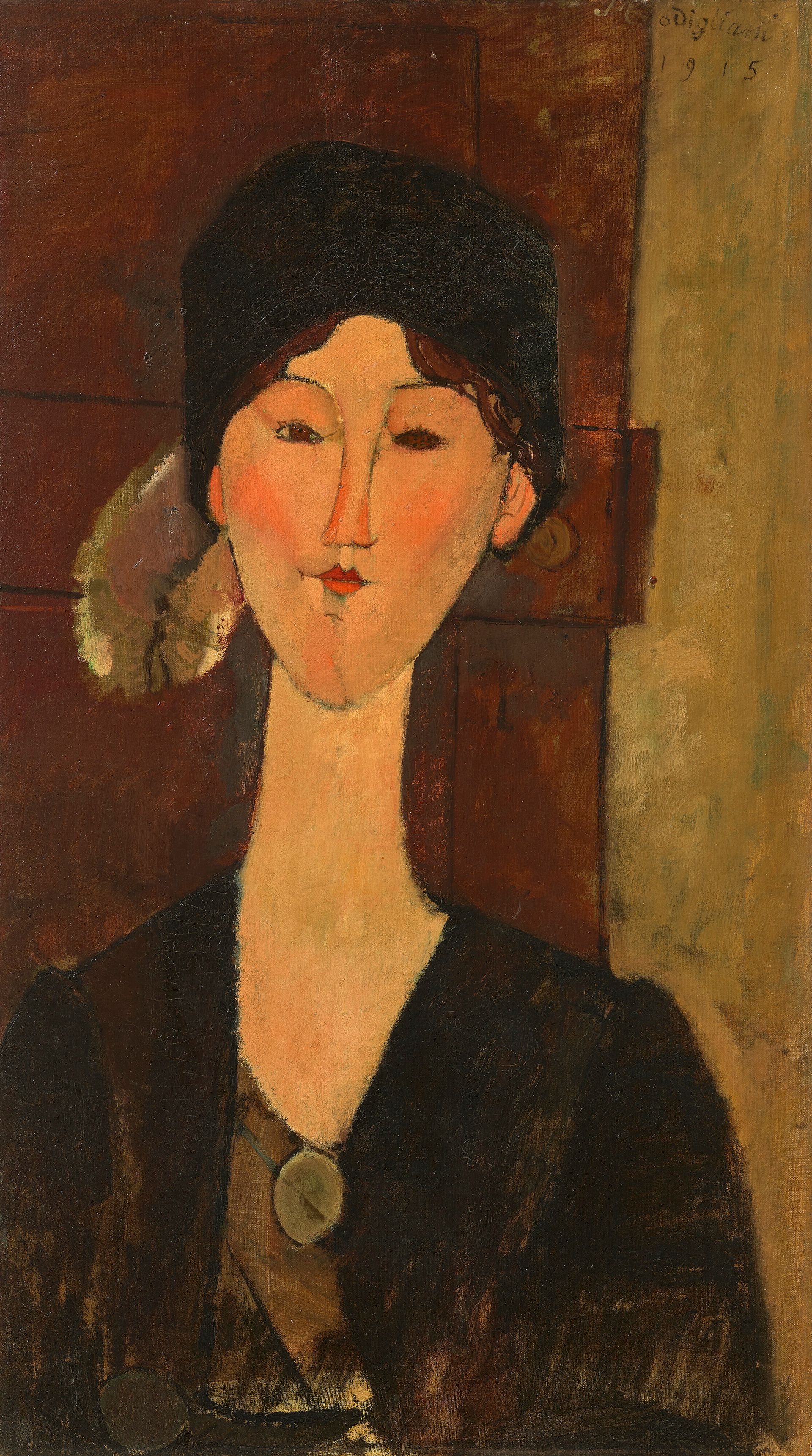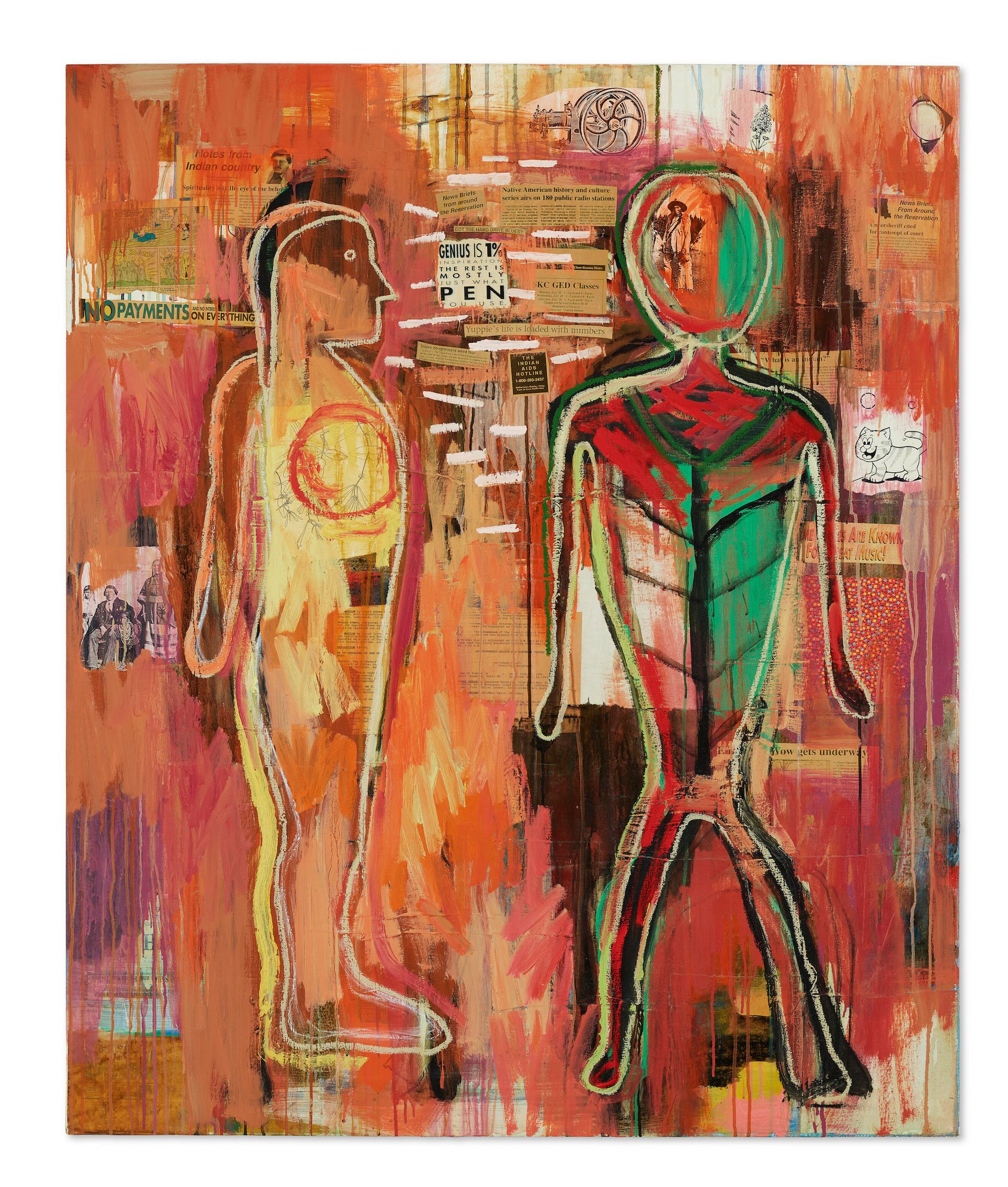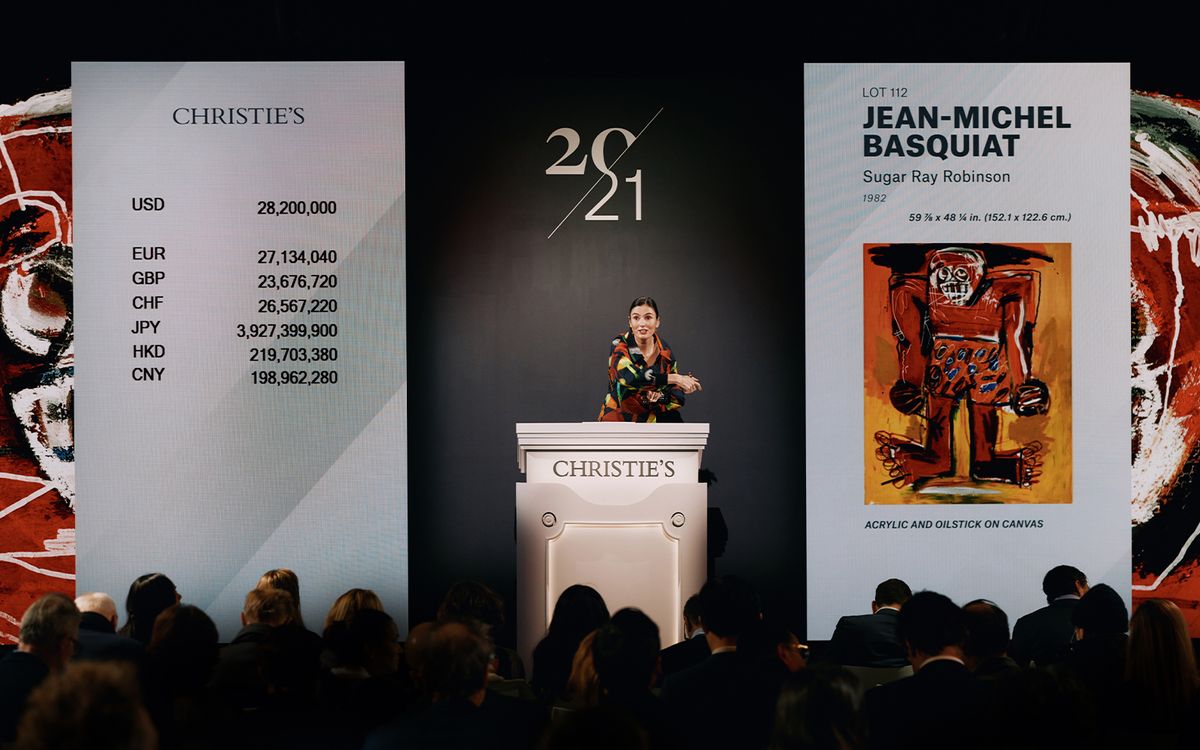Bucking auction fatigue and a seemingly endless smorgasbord of artists ranging from Edouard Manet to Andy Warhol, Christie’s delivered a $421.9m (with fees) marathon pair of evening sales at its Rockefeller Center headquarters on Thursday night (17 November). Split into 20th and 21st century lineups, the former realised a hammer total of $255.2m ($307.9m with fees) for the 69 lots sold and a svelte 4% buy-in rate by lot, while the latter clocked in at $95.2m ($114m with fees) for 35 lots sold and an 11% buy-in rate by lot.
For comparison sake, last November’s 20th century evening easily trumped this evening’s tally, realising $419.8m (with fees), as did the 21st century component, which brought $219.2m (with fees), for a combined and jumbo tally of $639 million. Still, Thursday night’s haul was a huge result thanks in significant part to a rash of guarantees in both categories, with at least 41 third-party guarantees booked in the 20th century sale, and seven and counting in the 21st. Eight artist records were set, with three in the 20th century sale and five in the 21st century sale.
A 20th century sale with blurry boundaries
The marathon evening got off to a rapid start with Howardena Pindell’s large-scale abstraction Untitled from 1971 (est $500-$700,000), which sold to Florence-based collector Christian Levett for $850,000 ($1m with fees). “I have a big collection of Abstract Expressionist female artists,” said the collector as he made a beeline for the exit.
René Magritte’s index card-sized constellation pairing a green apple with the globe set against a starry sky in gouache, L’autre son de cloche (1952, est $2m-$3m), made $3m ($3.6m with fees), and a second Magritte offering, Le monde visible (1963, est $7m-$10m), made $7.8m ($9.3m with fees. Still in that astral vein, Remedios Varo’s Surrealist composition with ghostly figures, Creación con rayos astrales (1955, est $2.5m-$3.5m), executed in oil and tempera on Masonite, realised $2.8m ($3.4m with fees).
Egon Schiele’s gouache and watercolour depiction of a contorted figure, Frau, das Gesicht verbergend (1912, est $1.5m-$2.5m), is a restituted work from the heirs of Viennese cabaret and film star Fritz Grünbaum, who was murdered in the Holocaust. It sold for $2.1m ($2.5m with fees). Alberto Giacometti’s Surrealist-infused bronze from a 1959 cast, Femme couchée qui rêve (est $3m-$5m), brought $3.1m ($3.7m with fees).
As in the most recent market fashion at auction, the pacing of the evening jumped decades and epochs without apparent rhyme or reason, as Claude Monet’s 1880 ripening still life, Le panier de pommes (1880, est $4m-$6m), sold for $4m (($4.8m with fees). Yes, you read correctly, a 19th century work crept into the 20th century category. It last sold at auction at the same house in November 2005 for $2.6m before fees and came back this round with a house guarantee.
Another 19th-century contender, Edouard Manet’s stunning page-sized scene, Le bal de l’Opéra (est $4m-$6m), dating from 1873 and highlighting a young bearded gentleman in a top hat, sold for $3.2m ($3.9m with fees). It made the equivalent of $2.6m when it last appeared at auction, at Sotheby’s London back in December 1996. It certainly was a historic provenance prize given that Gertrude Stein was an early owner

Amadeo Modigliani, Beatrice Hastings (devant une porte), 1915 Courtesy Christie's Images Ltd. 2022
Among the bigger hitters, Amedeo Modigliani’s classic, long-necked beauty, Beatrice Hastings (devant une porte) (1915, est $12m-$18m), realised $15m ($17.5m with fees) and the ravishing, rare-to-market Pablo Picasso Cubist masterwork, Buffalo Bill (1911, est $10m-$15m), barely trotted to $10.5m ($12.4m with fees). The Picasso last sold at Sotheby’s London in December 1986 for the equivalent of $1.07m.
Jumping ahead to the post-war years, Willem de Kooning’s magisterial and juicy abstraction from his storied East Hampton-era series, Untitled II (around 1978), tanked at a chandelier bid of $27m. The unpublished estimate for the work was in the region of $35m. It came with a house guarantee, so Christie’s is the proud new owner of the temporarily spurned painting. A later and decidedly spare De Kooning, as if it were on a crash brushstroke diet, Untitled” (1985, est $8m-$12m), sold to a telephone bidder for $7.8m ($9.3m with fees).
Sticking with late-in-career works, Joan Mitchell’s massive diptych from 1989, ablaze with a riotous palette, charged to $12m ($14.1m with fees), against an estimate of $10m to $15m.
Several of the entries from the ongoing liquidation of the collection of late Swiss dealers Thomas and Doris Amman popped, with Robert Ryman’s white-on-white abstraction, Untitled/Winsor (1965, est $6m-$8m), sold to Susan Dunne of David Zwirner Gallery for $10.7m ($12.5m with fees). “It’s a gorgeous thing,” Dunne said as she departed the saleroom, “and really a rare opportunity since Bob only made six of these in his career.”
Another Ammann lot, Andy Warhol’s black t-shirted Self Portrait (1964, est $3m-$5m), sold to dealer Alberto Mugrabi for $2.7m ($3.3m with fees). A later and larger Warhol, also from the Ammanns, Hammer and Sickle (1976, est $4m-$6m), realized $3.6m ($4.3m with fees). Mugrabi was the underbidder. Staying for a moment in the Pop art realm, Roy Lichtenstein’s yellow-hued tondo, Mirror #5” (1970, est $3.5m-$5.5m), barely glared at $2.6m ($3.1m with fees). Originally gifted to the artist’s son Mitchell Lichtenstein by his father the year it was painted, the proceeds will support reproductive rights and the Groundswell Fund, thanks to the consignor, the Agnes Gund Foundation.
A late Mark Rothko, glowing in fields of red and orange hues from 1969 and executed in acrylic on paper laid down on canvas (est $15m-$20m), sold for $15m ($17.5m). It shared top lot honors with the Modigliani. It last sold at auction at Sotheby’s New York in May 1988, when the art market was on fire, for $308,000 (including fees).
The only photograph in the sale was a star lot, with Man Ray’s iconic Noire et Blanche (1926, est $1.8m-$2.2m), which soared to $3.3m ($4m with fees. Lower East Side dealer Hong Gyu Shin of Shin Gallery was the underbidder.
The 21st century punches above its weight
The long evening switched gears and auctioneers as the 21st century category took over, leading off with Jaune Quick-To-See Smith’s figurative paper collage on canvas, I see Red: Talking to the Ancestors (1994, est $80,000-$120,000), which set a new record for the artist at $510,000 ($642,600 with fees), and Salman Toor’s sombre yet somehow riveting group portrait, 4 Guests (2019, est $120,000-$180,000), which sizzled at $680,000 ($856,800 with fees).

Jaune Quick-to-See Smith, I See Red: Talking to the Ancestors, 1994 Courtesy Christies Images Ltd. 2022
Figurative works by artists of colour, and not the usual gang of middle-aged white guys, were in abundance, as evidenced by Noah Davis’s Congo #7, featuring a trio of three young men framed in shades of gray by a doorway, which sold for a record $1.4m ($1.5m with fees), well ahead of its $400,000 to $600,000 estimate. Similar in some ways but bursting colours, Toyin Ojih Odutola’s Last Dance at the Annual County Gala” (2016, est $600,000-$800,000), went for $480,000 ($604,800 with fees).
The Beautyful Ones (2012, est $4m-$6m), a king-sized work depicting the artist’s sister surrounded by collaged cutouts of family albums by Los Angeles artist Njideka Akunyili Crosby, went for a record $3.9m ($4.7m with fees). It last sold at Christie’s London in March 2017 for a then-record £2.5m (with fees) against an estimate of £400,000 to £600,000.
In a more abstract vein, Rashid Johnson’s hot-off-the-presses Surrender Painting Sunshine (2022) hit a record $2.45m ($3m with fees).
The brawny cover lot came up early in the sale, with Jean-Michel Basquiat’s domineering and gloved boxer, Sugar Ray Robinson (1982, est $35m-$55m), entering the auction ring and lightly punching its way to $28.2m ($32.6m with fees).
“I think it’s a $50m painting,” said Alex Rotter, chairman of Christie’s 20/21 Art department and who took the winning telephone bid for an anonymous client. “It was a very good result for a very good painting.” The room, it appeared, didn’t think so. It last sold at Christie’s New York in November 2007 for a hammer price of $6.5m.
Another 1980s contender, Jeff Koons’s silvery Jim Beam-J.B. Turner Train (1986, est $15m-$20m), still bright and shiny in stainless steel (and holding real bourbon), went for $14.5m ($16.9m with fees). Another version (the artist’s proof from an edition of three) sold for $33.7m (with fees) at Christie’s New York in May 2014. That’s a sobering thought.

Jeff Koons, Jim Beam - J.B. Turner Train, 1986 Courtesy Christie's Images Ltd. 2022
Still sifting through New York’s downtown 1980s art scene, Keith Haring’s upside-down breakdancing figure in enamel and DayGlo on metal, and sheathed in the artist’s painted frame, went for $4.8m ($5.8m with fees), firmly within the $4m to $6m estimate. This is its third time at auction, following the one here in May 2006, when it brought $553,600.
Back amongst works from the Ammann collection, Bayonne (1986, est $400,000-$600,000), Eric Fischl’s large-scale diptych featuring a seated nude and a standing girl outfitted in a tutu sold for $470,000 ($592,200 with fees). Back on an abstract track, Christopher Wool’s densely patterned work, resembling an array of pitch-black flower petal shapes, Untitled (1993, est $8m-$12m), executed in enamel on aluminum, brought $7.5m $8.9m with fees).
The three evenings at Phillips, Sotheby’s and Christie’s—and not counting the $1.6bn Christie’s sold from Microsoft co-founder Paul G. Allen’s collection last week—tallied $875.7m with fees, compared to the cumulative take of $967.9m at those houses last November. The takeaway? Despite challenging economic and geopolitically fraught times, the global art market is still awash with cash and a seeming abundance of international buyers.


